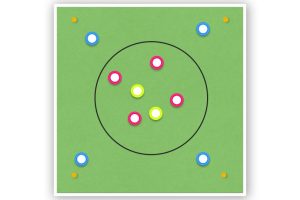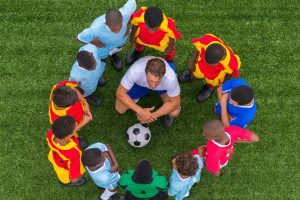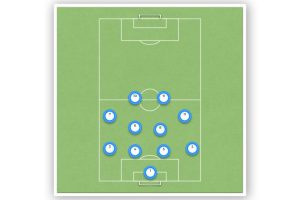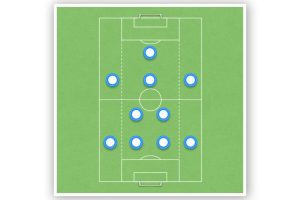How To Include Goalkeepers In Your Sessions
As coaches, we constantly seek to evolve our training methods to keep pace with the dynamic nature of soccer. A critical player in any successful team is the goalkeeper. Their role has transcended mere shot-stopping to become a pivotal part of the offense, initiating attacks with precise distribution.
Mastery over a varied range of passes is now as crucial as traditional goalkeeping skills. Akin to a golfer’s selection of clubs, a modern goalkeeper needs to be versatile.
Understanding the modern goalkeeper’s toolkit is essential. Coaches should focus on enhancing keepers’ agility in positioning, both with and without possession. They should also work on their ability to communicate effectively under pressure.
Enhancing the bravery of goalkeepers is also important. Not just in physical duels, but also in retaining possession and playing with confidence in tight spaces.
Integrating goalkeepers seamlessly into team practices enriches their skill set. It also emphasizes their importance as a valued team member.
Key Takeaways
- Coaches should emphasize versatile distribution skills in goalkeeping training.
- Goalkeepers need to develop positioning, communication, and bravery for modern soccer.
- Including goalkeepers in team sessions improves their skills and team integration.
Essential Skills of a Soccer Goalkeeper
Thwarting Shots
A goalkeeper’s primary role is to prevent the ball from entering the net. Adhering to time-tested principles is a cornerstone of effective shot-stopping.
- Anticipation: Predicting the trajectory of the ball.
- Reflexes: Reacting swiftly to shots.
- Technique: Employing the correct save technique for each shot.
Initiating Offensive Plays
Modern goalkeepers play an active role in launching offensive strikes by distributing the ball effectively.
- Vision: Recognizing opportunities for constructive play.
- Distribution: Mastering various passing techniques to aid team movement.
Strategic Placement
Proper placement on the field, whether in or out of possession, enhances a goalkeeper’s effectiveness.
| Location | Importance |
|---|---|
| In possession | Being accessible for back-passes. |
| Out of possession | Adapting position based on ball location. |
Ball Control Proficiency
Goalkeepers frequently interact with the ball, necessitating proficient ball-handling skills.
- First touch: Controlling incoming passes cleanly.
- Playing under pressure: Maintaining composure while in possession.
Tactical Communication
Clear and decisive communication fortifies the defensive structure and aids in orchestrating the team’s movements.
- Vocal leadership: Directing teammates through commands.
- Awareness: Understanding team dynamics to guide play.
Managing Varied Shot Types
Adapting to different shooting scenarios is vital. Each situation requires a tailored approach to handling the ball.
- Diversity: Dealing with shots of varying speed and complexity.
- Technique adaptation: Adjusting technique to match the type of incoming shot.
Valor in Possession
Beyond physical courage, goalkeepers must exhibit mental resilience, especially when under pressure or in tight spaces.
- Composure: Retaining the ball confidently amidst challenges.
- Mental strength: Exercising decision-making courage close to the opponent.
Engaging Keepers in Training Sessions
Working with Specialists for Goalkeepers
In training environments where a dedicated goalkeeper coach is present, collaborating with them can enhance session planning. This ensures the integration of goalkeepers into the team’s activities.
Coaches should discuss with the specialists about session objectives and seek advice on tailored drills. These drills should refine the goalkeepers’ skill sets, encompassing aspects like positional awareness, distribution techniques, and communication with the team.
Structuring Training for Keepers
When planning training sessions, coaches should aim to embed goalkeepers in drills in a way that promotes their active participation.
This may involve designing exercises that not only test their traditional goal-stopping capabilities, but also their skills in launching counter-attacks.
Ensuring that keepers get ample opportunities to employ various ‘clubs in their bag,’ from short passes to long kicks, will help them adapt to modern playing styles.
Implementing Target-Based Drills
Target games can be an effective strategy to work on a goalkeeper’s footwork and distribution under pressure.
Coaches can utilize the goalkeeper as the target to enhance their precision in playing out from the back.
For instance, setting up drills where goalkeepers must distribute the ball accurately to teammates or return it with prescribed restraints encourages varied use of techniques.
Including Goalkeepers in General Practices
It is beneficial to integrate goalkeeping drills into sessions for all players, especially at younger ages.
Such inclusion can help players develop basic goalkeeping skills and prevent over-specialization too early.
In addition, this approach can potentially reveal natural talents in the goalkeeper position and offer solutions for scenarios when the main keeper is unavailable.
Engaging every player in goalkeeper exercises contributes to a versatile and well-rounded team.
- Positioning and Footwork Inclusion: Ensure training activities replicate in-game scenarios that improve the keeper’s decision-making abilities, such as when to distribute with the feet or hands.
| Drills | Purpose |
|---|---|
| Distribution with feet | Develop accuracy in launching attacks |
| Shot-stopping in constrained spaces | Enhance reaction and close-range save abilities |
| Simulated in-game pressure scenarios | Foster calmness and bravery in possession |
- Communication and Commanding Presence Development: Foster a sense of leadership and awareness, enabling goalkeepers to effectively guide the defense and organize the team from behind.
Note: Always consider the context of the drill to support the keeper in developing relevant skills that translate to improved performance during matches.
Challenges in Safeguarding the Net
In the evolving landscape of football, the art of goalkeeper training requires a sophisticated approach to foster players adept at not only preventing goals but also kick-starting offensive maneuvers. Below are key skills and practices vital in modern-day goalkeeper development.
Essential Goalkeeper Competencies:
- Shot Blocking: The fundamental task remains unchanged; goalkeepers must excel at keeping the soccer ball out of the goal.
- Distribution Proficiency: Modern goalkeepers should possess versatile ‘footwork’ akin to selecting the right club in golf, varying from powerful long-range kicks to precise short passes.
- Positional Awareness: Whether the team is attacking or defending, a goalkeeper’s positioning can be critical. They must read the game effectively and adapt their position accordingly.
- Ball Reception: With increased backpasses, goalkeepers require superior skills in receiving and handling the ball under pressure.
- Communication: The ability to clearly direct teammates is essential. Vocal and assertive communication can influence the team’s dynamics and defensive positioning.
- Reflexes and Handling: The variety of shots faced demands acute reflexes and sure-handedness in making saves.
- Courage in Possession: Goalkeepers need bravery not just in physical challenges, but also in taking risks with ball possession in tight spots. This contributes to the team’s play style and ball retention.
Integrating Goalkeepers in Team Sessions:
- Involving goalkeepers in session planning is crucial. When designing drills, consider how the goalkeeper can participate effectively.
- Utilize goalkeeper coaches, if available, to seamlessly blend specific goalkeeper training within broader team exercises.
- Implement games that incorporate goalkeepers as active participants, such as target games that engage their distribution skills.
Go beyond Segregation:
- Avoid sidelining goalkeepers, particularly in youth setups. All players, regardless of position, can benefit from basic goalkeeper training to foster versatility and solve issues arising from the absence of a specialized goalkeeper.
Enhancing Team Integration and Tactical Drills for Goalkeepers
In soccer, the role of a goalkeeper is pivotal. They safeguard the goal and initiate attacks, making them the linchpin in transitioning from defense to offense. This requires a versatile skill set.
Coaches should prioritize a goalkeeper’s capacity to distribute the ball effectively. Possessing a varied ‘toolbox’ allows them to select the appropriate ‘club.’ This refers to the type of pass they choose depending on the game’s demand.
Defensive positioning and an acute sense of situational awareness are essential. Goalkeepers must also have adaptive positioning during possession shifts.
Goalkeepers must also hone their reception skills due to the increased back-passes seen in modern play. This enables them to recycle the ball proficiently within the team.
Good communication is pivotal. Goalkeepers often serve as the team’s vocal backbone, guiding and organizing the team’s defensive structure.
Their ability to handle different types of shots and maintain effective positioning for saves cannot be underestimated. Additionally, mental fortitude such as bravery, notably in tight spaces, further distinguishes top goalkeepers.
Incorporating goalkeepers into team practices ensures their integration into the team dynamic. Coaches must strive to include them in drills meaningfully. They should utilize their unique skills in various scenarios, from target games to ball distribution practices.
Key Considerations for Goalkeeper Training
- Distributive skills: Enhance the goalkeeper’s ability to initiate attacks with accurate passes.
- Positioning: Improve the goalkeeper’s situational placement based on game context.
- Reception: Train goalkeepers to receive backs comfortably from defenders.
- Communication: Strengthen the goalkeeper’s communicative role within the team.
- Handling: Practice varied shot stopping and handling to expand their defensive repertoire.
- Fortitude: Foster the goalkeeper’s composure and confidence in high-pressure scenarios.
Inclusive Drills Advisory
- Practice Design: Integrate goalkeepers into the team’s training routine to cement their role in the squad.
- Role Rotation: Encourage all players to experience goalkeeping duties to uncover potential talent and provide alternatives during absences.
- Tactical Games: Modify pitch dimensions for concentrated practice, increasing the frequency and realism of shots that goalkeepers face.
- Contextual Training: Instead of isolating goalkeepers, utilize tactical team games that reflect actual match conditions.








